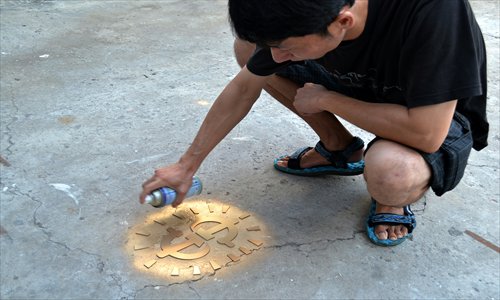Bitter, yet cool

One of the first symbols greeting visitors to at the entrance of the TJ in China Project Room, Caochangdi's latest gallery, is a "communist dollar" spray painted on the ground by Chinese artist Dai Hua.
Mirrored, symmetrical insignias of communism's hammer and sickle side by side make them resemble a dollar sign, offering a thought-provoking preview for visitors of Dai's eccentric solo exhibition that opened on Saturday.
Animated tanks, the Chinese zodiac and pixilated images detailing the country's past century converge in Dai's artworks. Simple yet ironic, the exhibition entitled "It's cool to be an artist (in China)" includes 10 pieces dripping with mythical, historical and pop cultural influences that illustrate the bittersweet life of an artist in China. Little cubes with legs run in front of animated excavators in Dai's animated video The End. "If you want to build something new, you first need to nip it in the bud," said Dai, 36, who mixed Beethoven's "Ode to Joy" with Chinese requiem song "Funeral Music" for the video's soundtrack.
"My art is just Ctrl+C, Ctrl+V - cut and paste," joked Dai, a self-confessed history buff who studied computing and used to design CD covers, T-shirts and websites.
He uses computer-generated art to creatively and sarcastically poke fun at tradition and authorities. Dai used a Chinese pun to express the irony of being an artist free to express feelings and convey messages, yet unable to make enough money or change reality.
"Kubi literally means 'bitter force,' but depending on the tone in pronunciation it can mean 'cool' or 'miserable,'" Dai said through a grin, referring to the fourth and third tones respectively.
Many visitors have been drawn to Map of China (1911-2010), which bears a playful similarity to the children's book Where's Waldo? The huge image is crowded with a witty parade of symbols and imagery reflecting China's political and social changes.
Population growth, the evolution of the significance of the term tongzhi (Chinese slang for "homosexual"), and China's sometimes rocky relations with its neighbors are all featured.
"It's a very ironic revision of China's history over the last century, with harsh criticism directed toward the current government and society," said Esteban Andueza, an independent curator at the opening of the event. "I see some of the criticism that was done in the 1990s. Only Dai uses other formats and tools like the computer.
"Dai contradicts the common idea that art needs to be complex in order for it to be striking," noted Andueza.
The techniques Dai uses to incorporate creative freedom and important political aspects particularly appealed to Mexican artists Mely Barragán and Daniel Ruanova, co-founders of the gallery.
"Dai is representative of a generation of Chinese artists who switched from analog to digital, and whose work is much more conscientious and critical of China," said Ruanova.
When: Until September 8
Where: TJ in China Project Room, 300 Caochangdi Village, Chaoyang district
Admission: Free
Contact: 182-1082-4074 or visit: tjinchina.dinstudio.com